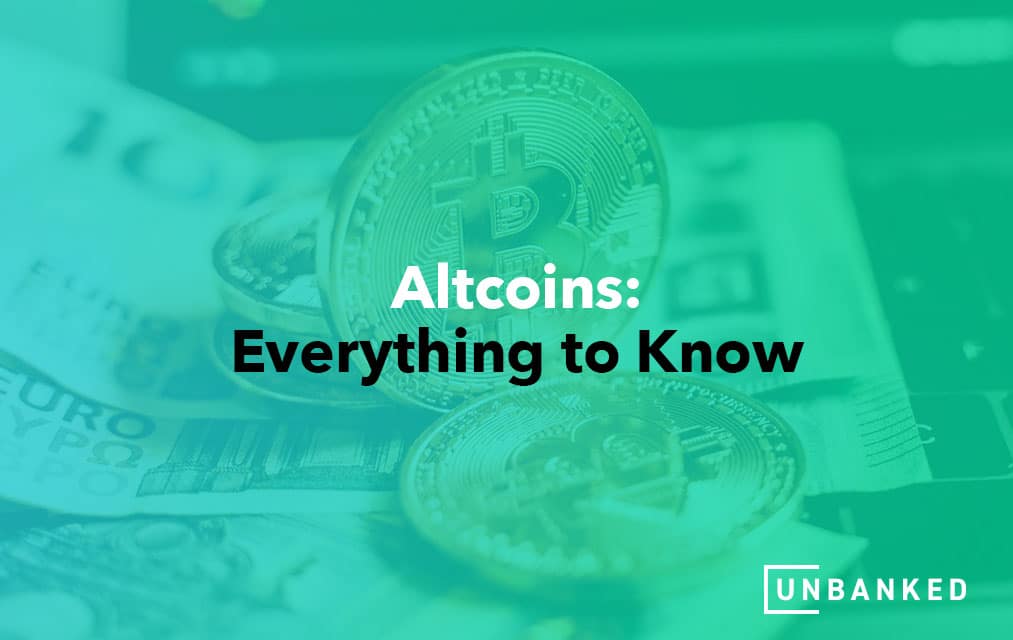The definition of altcoins is simple — any cryptocurrency that is not bitcoin is an altcoin. That means there are a ton of them out there: over 10,000, according to CoinGecko. Because bitcoin makes up about 40% of the total market, over half of the total value of the crypto market is in altcoins.
But all altcoins are not the same. For example, some might cost pennies, while others can cost hundreds or thousands of dollars per coin. In addition, many altcoins aim to build on bitcoin’s success, while others claim to solve the cryptocurrency’s problem.
Looking to learn more about the basics of Crypto? Check out our Crypto terms every investor should know.
How Altcoins Differ From Bitcoin
To grasp the concept of altcoins, it’s essential first to understand bitcoin. It also helps to understand the basics of the blockchain — the technology on which every cryptocurrency operates.
Altcoins operate on the same premise as bitcoin, which uses blockchain technology as a distributed public ledger to allow and record only legitimate transactions. However, many altcoins use this premise to achieve different goals or improve flaws found in bitcoin.
For example, Litecoin began as a bitcoin clone with changes to improve storage efficiency and speed up transaction times. While it served the same purpose, its founder looked for ways to improve the process.
On the other hand, Ethereum saw an opportunity in blockchain technology beyond recording financial transactions. It created smart contracts, which a program automatically executes when the conditions of the agreement are met. These smart contracts could disrupt industries that rely on middlemen, particularly banking and insurance companies.
We’ve seen many other altcoins emerge with promises of being even faster, more scalable, more secure, more decentralized, or combining those core cryptocurrency tenets. As a result, we can break down altcoins into four categories.

Native Cryptocurrencies
These are the coins created to operate on specific blockchain networks. For example, bitcoin is a native cryptocurrency because it runs on the bitcoin blockchain.
Ether, which is second behind bitcoin by market cap, is also a native cryptocurrency that operates on the Ethereum network.
Binance coin, in fourth place, is yet another native cryptocurrency. It operates on the Binance Chain, the largest cryptocurrency exchange worldwide
Tokens
You can think of using tokens like when you go to an arcade and exchange money for a token accepted by the game machines. They operate on an existing blockchain, and you can use them for specific purposes in that environment.
For example, Chainlink, which is built on the Ethereum blockchain, lets developers convert real-world data into a more blockchain-friendly format that smart contracts can use. The service’s token is called LINK. So, investors who believe the demand for smart contract services will rise might buy LINK tokens with the thought that the higher demand would also raise the token’s value.
For another example, look at the Uniswap platform — an exchange built onto the Ethereum system. While centralized exchanges like the stock market require investors to deposit into a wallet or account connected to the exchange, decentralized exchanges like Ethereum allow direct peer-to-peer trading. UNI is the token used on the Uniswap exchange and is what we call a governance token. That means holders of UNI have a say in how the platform operates, like how traditional shareholders can influence corporate governance.
Related: How to Mine Crypto
Stablecoins
People develop stablecoins to take advantage of the features of cryptocurrency without price volatility. Stablecoins are tied to the value of existing currencies. For example, the largest stablecoin, Tether, is linked to USD — one Tether is equal to one US dollar.
Price appreciation is not a feature of stablecoins, but there are applications for coins with a relatively stable value.
One of the most common uses for stablecoins is decentralized finance (DeFi). Essentially, these platforms allow users to lend out their stablecoins, earning interest in return without an intermediary. And some platforms incentivize this by offering tokens in addition to the interest they receive.
Forks
In the cryptocurrency blockchain, each group of recorded transactions gets organized into blocks, and then each block gets connected to the next through complex cryptography. In order for a new block to get added to the chain, each previous transaction and every previous block must be verified, and the general consensus must state that everything is legitimate.
The blockchain network requires a consensus for both the rules that govern the network and the list of transactions. So when a group decides to change the rules, it can create a split in the chain, which we call a fork. Then a new chain emerges and is ready to start logging new transactions under those rules agreed upon by the people who validated the fork. Meanwhile, the original prongs of the fork continue operating as normal.
These forks can happen repeatedly and create new cryptocurrencies and protocols each time. For example, bitcoin cash is a fork that came from the original bitcoin blockchain.
As an investor, if you like the rules, changes, and ideas found in a fork of a blockchain, you could purchase that fork’s currency with the hope that it rises in value.
Types of Altcoins
Altcoins are cryptocurrency tokens that differ from the more well-known Bitcoin. While Bitcoin is used mainly as a store of value, altcoins can be used for everything from media storage and distribution to smart contracts, gaming tokens, and beyond.
Altcoins come in many different varieties. Here are some of the best types of altcoins:
Utility Tokens
Utility tokens are digital assets that provide users with access to services or products provided by the issuer. These tokens represent a claim on future products or services offered by the company that issues them and make it easier for companies to raise capital through ICOs (Initial Coin Offerings).
Security Tokens
Security tokens offer holders rights similar to those associated with traditional securities, such as equity and debt instruments. They are considered to be more reliable than utility tokens since they represent an investment in the company’s economic performance.
Stablecoins
Stablecoins are designed to minimize volatility by pegging their value to some external reference point like a fiat currency or a commodity such as gold. These digital coins offer investors the best of both worlds — the upside potential of crypto and the stability of traditional investments.
Privacy Coins
Privacy coins, such as Monero and Zcash, are digital tokens that offer more privacy than traditional cryptocurrencies. These coins have built-in features that make it difficult to trace transactions, as well as features like stealth addresses and ring signatures that further obfuscate user identity while still allowing for secure payments.
Meme Coins
Meme coins are digital assets that often have little to no use case other than as a digital asset for trading and speculation. These coins tend to be highly volatile and often lack any real long-term value, so it’s best to approach them with caution! Examples include Dogecoin and Safemoon.
Payment Token
Payment tokens, like Bitcoin, are digital currencies that can be used to pay for goods and services. These tokens are typically accepted by merchants as a form of payment just like traditional fiat currencies.
As you can see, there is a wide variety of altcoins available on the market today — each with its own set of benefits and drawbacks.
It’s important to conduct your own research when investing in any type of cryptocurrency so you can make an informed decision about which best fits your needs and risk tolerance level. With the right knowledge and understanding, anyone can become a successful crypto investor!
Related: https://unbanked.com/non-fungible-tokens-nft/

Pros and Cons of Altcoins
Altcoins can be a great way to diversify your portfolio and increase potential returns, but they also come with certain risks. Here are some of the main pros and cons to consider when investing in altcoins:
Pros
– Diversification: Altcoins provide an opportunity to diversify your investment portfolio. This helps reduce risk since it’s difficult for all altcoins to suffer at the same time.
– Potentially high returns: Because altcoins are still relatively new, there is more upside potential than established coins like Bitcoin. If you get in early, you could see higher returns on your investment.
Cons
– High volatility: Due to the relatively small market capitalizations of many altcoins, they can be extremely volatile. This means you could potentially lose money if the price drops quickly.
– Lack of liquidity: Many altcoins have low trading volume, which means it can be difficult to buy or sell large amounts without significantly affecting the price.
– Scams & Frauds: Unfortunately, there have been a number of scams and frauds related to altcoin investing. Always conduct your own research before investing in any cryptocurrency!
Related: https://unbanked.com/litecoin-vs-bitcoin/
What is the best altcoin?
The best altcoin for you will depend on your individual goals, risk tolerance level and investment strategy. There is no one-size-fits-all answer to this question as different types of altcoins offer different advantages and drawbacks.
It’s important to do your own research when looking into any type of cryptocurrency investment — be sure to read the whitepaper, conduct due diligence and consult a financial advisor before making any decisions. With the right knowledge and understanding, anyone can become a successful crypto investor!
Is Shiba Inu a altcoin?
Yes, Shiba Inu (SHIB) is an altcoin. It’s a decentralized token based on the Ethereum blockchain and has been gaining traction due to its increasing popularity and scarcity.
While SHIB has seen rapid growth in price recently, it’s important to remember that all cryptocurrencies are highly volatile and can go up or down quickly — so always invest responsibly.
Is Solana an altcoin?
Yes, Solana (SOL) is an altcoin. It’s a blockchain platform designed to support high-performance decentralized applications and has been gaining traction due to its scalability and low transaction fees.
SOL tokens can be used to pay for services on the Solana blockchain, as well as traded like any other cryptocurrency.

Interested In Investing In Altcoins?
Before purchasing altcoins, it’s crucial to read through what the network behind them is trying to achieve. For example, ask yourself:
- Does the altcoin improve upon other cryptocurrencies?
- For tokens, do they have a real-world application?
- For stablecoins, how do you plan to use them?
For forks, why were they created, and do you agree with the new rules and changes?
You should also understand that it’s a nascent market, and a shakeout is inevitable. Many altcoin projects will fail — and many already have — while others will succeed.
Financial experts often categorize altcoins as an alternative investment. They are something most people dabble in once they already have a healthy, diversified investment portfolio.
Learn more about altcoins, stablecoins, cryptocurrency, and more with our free resources. And if you’re ready to invest in alternative currencies, sign up for your free BlockCard account today!
Related: Crypto Arbitrage: Beginner’s Guide





